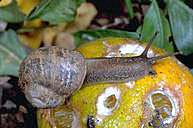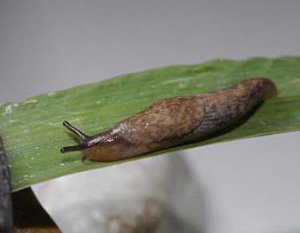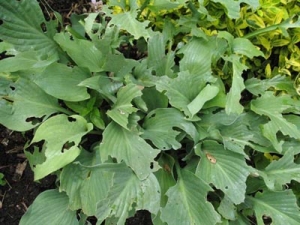Snails and Slugs — A Garden’s Thugs
By Elaine Homstad, Fairfax Master Gardener
What is the definition of a slug?
A snail with a housing problem!
I know. It’s a very old joke. But its punch line truly is the primary difference between a snail and a slug. They are both in the mollusk phylum, and both are gastropods (literally, “stomach-foot”), that, despite their small size, can do quite a bit of damage to your garden’s ornamental and edible plants. They move by gliding along on a trail of mucus secreted by their “foot.” It then dries to form the telltale, silvery, slime trail — a sure sign of their presence in your garden.

Helix aspersa
The common, or brown, garden snail (Helix aspersa) is also the one served in French cuisine as escargots. It has a small, soft shell when it is born, which actually grows much like our fingernails do, but in a distinctive coil pattern.
The garden slug (the most common and destructive being the gray garden slug, Deroceras reticulatum) does not develop a shell, but rather has a raised ridge, or mantle, on its back. It is most active at night and on cloudy days and prefers cool to mid-range temperatures and moist, shady environments. So, of course, springtime and shade gardens become the ideal banquet conditions.

Derocera reticulatum
Slugs are much more prevalent than snails in our area. The gray garden slug is the one you are likely to find feasting in your yard. It is about 2 to 3 inches long at maturity, varying from light to dark in color, with brown specks and mottling. Both the immature and the adult slugs feed on plants. Their preference is tender, herbaceous plants (lettuces, short-stemmed flowers and hostas, for example), but fruits close to the ground (strawberries or beans) are also a favorite.
The slug is hermaphroditic, with both male and female organs, so all slugs can lay eggs, which they do multiple times each year, spring through fall, in clusters of 10 to 20 or more. Their round or oval, gelatinous eggs measure about one-quarter inch and are laid in damp shaded soil, under debris, mulch, groundcovers and ground-contacting items such as rocks, pots or garden ornaments. Slugs can overwinter in the egg, immature, or adult stages. Eggs can begin to hatch at 40-degree F. A mild winter followed by a wet spring creates an ideal condition for a very large population. Slugs grow slowly and can have a life span of from one to five years.

Slugs often leave large and ragged holes on leaves
Fortunately, they can be controlled, and these methods work for both slugs and snails. Here are some of the different methods, listed in order of effectiveness, from most to least:
1. Eliminate hiding places
Slugs and snails cannot survive in hot, dry, sunny or windy conditions. They thrive in moist, dark environments — beneath mulch, in thick groundcovers or in plant debris such as leaves or dead foliage; under rocks in gardens or borders; or under stone slabs or logs. As much as possible, practice good sanitation in the garden, keeping areas clean of debris and not mulching too closely to plant stems. Being aware of their potential hiding places, even if you cannot eliminate them all, will help you to know where to use baits or traps.
2. Lure, handpick and remove
Use the slugs’ natural behaviors to lure them. You can create a cover lure by placing flat stones, board or pieces of carpet, at least a foot square, in areas where you see evidence of slugs, either through sightings or plant damage and trails. It helps to raise the covers slightly so the snails and slugs can easily slither under them. In early morning and evening, turning the boards or stones over will reveal any number of the little critters. Then you can scrape or handpick (using protective gloves, of course), and either crush them or drop them into a bucket of soapy water. The dead ones can be left in the garden to decay, or placed in a composter, if you have one. If you want to have a nighttime adventure, you can search them out after dark using a flashlight. However, placing the cover lures and then harvesting in the morning and evening is much easier.
3. Create barriers
Because of their body structure, slugs avoid crawling over anything that is dusty or abrasive. Diatomaceous earth (a powder formed from tiny, fossilized organisms found in lakebeds) is always recommended, but it can be expensive and has to be refreshed frequently. Other materials that can be used are coarse sand (called builders’ sand), ashes, stone chips, lime or crushed eggshells. The eggshells have the advantage of not washing away after it rains. Be aware that lime application can affect the soil’s pH.
Other potential barriers are copper flashing and tape, and metal screening. The slug or snail is actually electrocuted when the mucus from their body reacts with the copper, sending a disruptive shock through their system – a gruesome but effective strategy for protecting your prized hostas or raised vegetable beds.
4. Use traps
Most gardeners know that slugs are attracted to beer. Actually, they are attracted to the yeast/sugar combination. Placing beer or a sugar-water/yeast combination in shallow pans (about 2-inches deep) sunk into the ground creates an effective trap. If you can place a loose cover over them, the traps will be all the more effective. You can buy traps that have sloped entry ports with wells inside and removable covers. The drawback to using these traps is that they have a limited range and do not trap nearly as many as the “lure-and-handpick” method. You also need to empty and replenish them often. This method is discussed by several state Extension Services. It is not, however, recommended in the Virginia Pest Management Guide.
5. Employ baits
While not very effective for the quick reduction of an infestation, the use of baits can help once you have reduced the population to a more manageable level. The best ones to use — that is, the least toxic to humans, pets and other wildlife — are those that contain primarily iron phosphate. They are sold under the names Sluggo and Escar-Go, among others. You can scatter the bait, which is in pellet form, on lawns, soil, or around or in any type of plant or plant bed. The other bait that can be used is one with the active ingredient of metaldehyde. It is, however, highly toxic to people and animals and is, therefore, mostly used in agricultural applications, where it can be more strictly controlled.
6. Rely on predators
Slugs are a delicacy for toads and garter snakes. Ducks also enjoy them, as do some other birds. If you have these predators in your landscape, they will help you a bit, but don’t depend on them to significantly reduce the slug population.
In conclusion, to help you to manage the slug and/or snail colonies in your garden, remember these three points:
- Know your enemy. Understand their behavior patterns and life cycles.
- Hit them where they live. If you cannot eliminate their hiding places, minimize their population by reducing them.
- Use a good Integrated Pest Management plan. A combination of methods always works better than just one.
Resources
Pest Management Guide , Publication 44-109, Virginia Cooperative Extension
Managing Slugs in the Garden and Beyond, Fact Sheet 5036, Maryland Cooperative Extension
Slugs, Fact Sheet 5036, UMaine Cooperative Extension
Snails and Slugs, UCDavis
Rodale Organic Life – Jan 6, 2011 & June 17, 2015